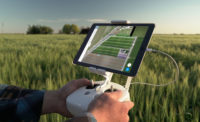GIT partnered with Metalforming Inc., Peachtree City, Ga., to develop the tool. Metalforming is a sheet metal folding company that is testing use of the video-derived roof measurements to drive on-site roofing panel fabrication machines.
The device comprises twin high-definition video cameras on an extendable pole. It is used to capture images in stereo, and then send the video images to a server that registers visual features from the left and right views. It matches the features over multiple frames, allowing extraction of 3D information and the generation of wireframe roof diagrams, which define the dimensions of the planes and angles from as-built conditions.
“First we extract the lines, then planes, then boundaries, then the measurements,” says research assistant Habib Fathi. He and a team of researchers at GIT led by Ioannis Brilakis are refining the algorithms used to match components in the video feeds and extract accurate measurements. The team aims to have a device and software on the market by summer 2012. They anticipate the first version will cost about $1,000.
“We have a machine that reads CAD models, or BIM, and cuts panels to fit them,” says Geoffrey Stone, Metalforming's CEO. But, he says, “we can’t cut metal panels to as-drawn BIM files because it’s not accurate enough. We need as-built.”
To get accurate as-built measurements of roofs, “most roofers end up pulling measuring tape several times during the roofing process,” says Stone. The manual process of climbing around the roof is difficult and can be dangerous.
Enter Brilakis' team of researchers from GIT. In 2007, Brilakis saw a device like a gun with a horseshoe-shaped barrel and a camcorder on each tip. It was an automated 3D imaging device to collect stereo video streams of small objects to produce digital 3D images in real time.
“I thought, what if I could take a gun like that and reconstruct a building?” recalls Brilakis.
After five years of research, and multiple grants—including an endowment from the National Science Foundation—Brilakis and his team have created a prototype that he claims can collect precise measurements of nearly any object at a distance of up to 20 meters. With Metalforming's backing, the prototype is being used to acquire as-built dimensions of roof planes and send them to the automated roof panel forming and cutting machines.
Brilakis says the pole-mounted prototype can be used from the ground to collect measurements without climbing. It sends the data directly to a server for processing on the spot, and then to Stone’s machine, which fabricates the panels precisely enough for installation.
Stone says no other existing measurement technology—including satellite imaging, phase-shifting lasers or total stations—is accurate, inexpensive and straightforward enough to be a reasonable alternative for roofing companies to use to get precise roof measurements. “We wanted something simple, cheap and accurate,” he says.
Jim Robillard, president of Wholesale Gutter, Houston, says he’s watching developments closely. He has been using a metal folding and cutting machine he bought from Stone for some time and he looks forward to the GIT data collection device. “I’m into productivity,” he says. He says the onsite metal forming machine already has increased productivity by 20%. The GIT data collection device would save even more time if it performs as is claimed.





